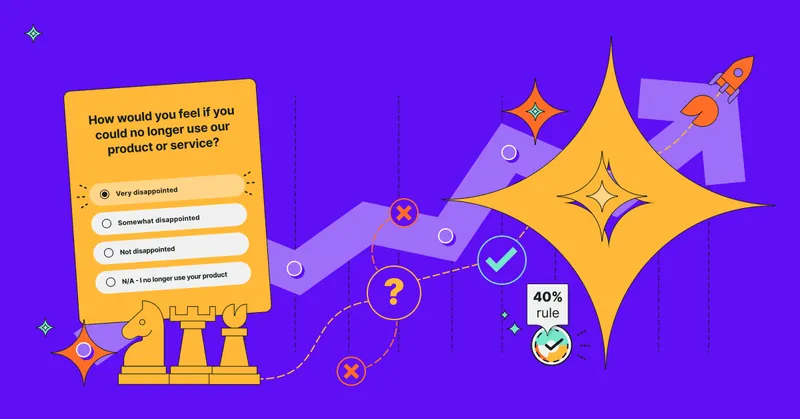Tl; dr;
- Unique Value Proposition (UVP) is key: Clearly define and communicate your UVP, which is the unique benefit that sets your product or service apart from competitors, to capture your target market's attention.
- Run in-depth competitor analysis: Conduct thorough competitor analysis to understand their strengths, weaknesses, and market share, and use this information to identify gaps and opportunities for differentiation.
- Do market segmentation: Segment your target market to tailor your positioning strategy, ensuring it is relevant and resonates strongly with specific groups within your audience.
- Use online surveys for competitive analysis: Run online surveys to gather customer feedback and actionable insights, which are crucial for refining your competitive positioning and understanding brand perception.
- Adapt and measure: Continuously track market trends, customer feedback, and use performance metrics to measure the effectiveness of your positioning strategy, adapting as necessary to stay competitive.

What is competitive positioning?
Competitive positioning is the strategy you employ to set your business apart in the market. It's about defining how your offerings differ from and are superior to those of your competitors.
To grasp the concept of competitive positioning, consider the following key elements:
- Market analysis: Start by evaluating the landscape within which you operate. Understanding the strengths and weaknesses of competitors gives you a clearer picture of the opportunities for differentiation.
- Customer needs: Pinpoint what your target audience values the most. Aligning your strengths with customer preferences ensures that your positioning resonates with them.
- Unique Value Proposition (UVP): This is your promise of specific value—what you deliver that others do not. Your UVP should be clear, compelling, and easily communicated.
When developing your competitive positioning strategy, address these aspects:
1. Identifying your positioning goals:
- Short-term vs. long-term objectives
- Product launches or updates
- Enhancements in customer service
2. Communicating Your Value:
- Use messaging that distinguishes your product's unique features or benefits.
3. Consistency Across Touchpoints:
- Ensure that every interaction with your brand affirms your UVP.
Remember, your aim is to carve a niche in the customer’s mind, making your brand the obvious choice for their needs. Properly executed, competitive positioning leads to a strong brand equity and a loyal customer base.
How to Develop a Competitive Positioning Strategy
Developing a competitive positioning strategy is essential for distinguishing your brand in the marketplace. It's about understanding your unique value, knowing your competitors, targeting the right market segments, and crafting messaging that resonates with your audience.
⭐️ Identify unique value proposition
Your unique value proposition (UVP) is the cornerstone of your competitive positioning. It articulates the singular benefit that makes your product or service better than the rest. To define your UVP, pinpoint the key features and benefits that set you apart. Always ask, "Why should customers choose you over your competitors?"
⭐️ Analyze competitors
To effectively position yourself, understand who you're up against. Perform a thorough competitor analysis by looking at product offerings, market share, pricing, and customer sentiment. Use tools like SWOT analysis to assess strengths, weaknesses, opportunities, and threats. Creating a comparison table can help visualize where you stand:
Competitor Strengths Weaknesses Pricing Market Share Competitor A Wide range Higher cost Premium High Competitor B Eco-friendly Limited selection Mid-range Medium Your Brand Innovative Feature New to market Value Growing
⭐️ Segment the market
Divide your target market into segments based on criteria like demographics, behaviors, or needs. This ensures that your positioning strategy is tailored and relevant.
For example, if your product is a fitness app, market segments could include "busy professionals," "health enthusiasts," or "beginner athletes."
⭐️ Position messaging and branding
Your messaging and branding should reflect your competitive position and resonate with your chosen market segments.
Develop a brand voice and visual identity that communicate your UVP and create emotional connections with customers. Ensure consistency across all platforms to reinforce your positioning:
- Tagline: Memorable and encapsulates your UVP.
- Visuals: Distinctive and aligned with your brand values.
- Content: Engages and educates your audience on the benefits you provide.
Monitoring and adapting positioning
To maintain a competitive edge, you need to actively monitor your brand's market position and adapt to changing circumstances. This involves keeping a close eye on market trends and customer feedback.
Customer feedback analysis
Analyzing customer feedback provides direct insight into how your positioning resonates with your audience. Methods include:
- Surveys and questionnaires: Distribute these to gather structured feedback on your brand's perception.
- Feedback forms on your website: Encourage users to provide their input on your product or service directly.
- Customer service interactions: Keep records of common themes and comments from customer inquiries and complaints.
Utilize these insights to inform adjustments in your positioning statement, messaging, or other marketing strategies.
Remember, responding to trends and feedback helps ensure your positioning strategy remains effective and relevant.
Market trends tracking
You should establish a process for tracking market trends to detect shifts in the industry. This can include:
- Economic indicators: Watch for changes in consumer spending, inflation rates, and employment statistics.
- Industry reports: Regularly review reports from trade associations and market research firms.
- Social listening: Use tools to monitor social media for discussions about your industry, products, and competitors.
Competitive positioning techniques
Applying the right positioning techniques in today's competitive landscape can set your business apart. Here, you'll learn three core strategies to position your brand effectively.
Differentiation
Your goal with Differentiation is to ensure your products or services have unique features or attributes that stand out in the marketplace. You should:
- Identify key attributes that your target market values.
- Communicate these attributes clearly in your marketing efforts.
Brand perception studies
Brand perception reflects the beliefs or views that customers hold about your brand. To study this:
- Conduct surveys or focus groups to gather customer opinions.
- Tap into social media analytics to understand sentiment and engagement.
Analyzing these perspectives will offer insights into your brand's strengths and how it is differentiated from competitors.
Cost leadership
Adopting a cost leadership strategy means being the lowest-cost producer in your industry. To achieve this, consider:
- Streamlining operations to reduce costs.
- Utilizing economies of scale.
Focus strategy
A focus strategy involves targeting a specific market niche. You need to:
- Understand the specialized needs of your chosen segment.
- Tailor your products or services to meet these needs more effectively than competitors.
Evaluating market position
Being successful in your marketing strategy requires understanding where your business currently stands compared to others. Diligent analysis and structured methodologies are essential to evaluate your market position accurately.
Market share analysis
Your market share is a direct indicator of your position within the industry. Assess it by:
- Calculating total sales: Determine your total sales over a specific period.
- Identifying industry sales: Find the industry's total sales for the same period.
- Computing market share:
- Your Sales / Industry Sales * 100 = Your Market Share (%)
Utilize this information to see how you measure up against competitors and observe trends over time.
Competitive positioning models
While planning your marketing strategy, it is crucial to understand the various models that can assist you in evaluating your competitive positioning. These models provide frameworks to analyze competition, market dynamics, and internal factors.
Porter’s Five Forces
Porter’s Five Forces is a model developed by Michael E. Porter, which breaks down industry competition into five key forces:
- Bargaining power of suppliers: How much power your suppliers have over pricing and supply terms.
- Bargaining power of buyers: Customers' influence on your pricing and quality.
- Threat of new entrants: The ease or difficulty with which new competitors can enter your market.
- Threat of substitutes: The availability and attractiveness of alternative products your customers might switch to.
- Industry rivalry: The intensity of competition among existing players in your market.
Analyzing these forces helps you understand the strength of your position in the market and determine strategic direction.
SWOT analysis
SWOT analysis is another tool that allows you to conduct a competitive analysis and assess your company’s Strengths, Weaknesses, Opportunities, and Threats:
- Strengths: Attributes of your company that give you an edge over competitors.
- Weaknesses: Areas where your company may be disadvantaged relative to others.
- Opportunities: External factors you could exploit to your advantage.
- Threats: External factors that could jeopardize your position or performance.
A well-executed SWOT analysis can reveal pivotal insights into where your business stands and inform your competitive strategy.
BCG Matrix
Finally, the BCG Matrix, also known as the Growth-Share Matrix, helps you evaluate different products or services based on their growth rate and relative market share. It categorizes your products into four quadrants:
- Stars: High growth, high share products often in the rapid growth stage. They require investment to maintain their position and can eventually become cash cows.
- Cash cows: Low growth, high share products that generate more cash than they consume. These are often stable, mature products with a solid footing in the market.
- Question marks: High growth, low share products that can be unpredictable, requiring significant investment with uncertain returns.
- Dogs: Low growth, low share products with limited potential, often absorbing more cash than they generate.
Understanding where your products stand in this matrix helps you decide which ones to invest in, develop, or divest.
Challenges in competitive positioning
Navigating the landscape of competitive positioning involves overcoming certain obstacles. Your strategy must adapt to an ever-changing market where hurdles like market saturation, shifting consumer preferences, and technological advancements persist.
Market saturation
As industries become more crowded, the struggle to carve out a unique space for your brand intensifies.
Market saturation implies that you face a higher volume of competitors offering similar products or services. This elevates the importance of differentiating your brand to maintain visibility and relevance.
Evolving consumer preferences
Today's consumers are more informed and have higher expectations. You must stay attuned to changing consumer behaviors and preferences.
This constant evolution challenges you to reassess and refine your positioning to ensure it resonates with your target audience's current demands and values.
Technological disruption
The rapid pace of technological innovation can upend existing market dynamics, rendering yesterday's competitive advantages obsolete. Stay proactive in leveraging new technologies to enhance your offer, and be prepared to pivot your positioning strategy to retain a competitive edge in a technologically evolving landscape.
Measuring the effectiveness of positioning
To ensure your product thrives in the market, it's crucial to measure the effectiveness of its positioning. This involves assessing how well your product stands out compared to competitors and resonates with customers.
Performance metrics
You can measure positioning effectiveness by examining specific performance metrics. Some of these include:
- Market share: Indicates your product's hold in the market compared to competitors.
- Sales growth: Measures the increase in sales over a specific period, showing the acceptance and demand of your product.
- Conversion rates: The percentage of target customers who take the desired action, indicating successful positioning that prompts purchase.

- Customer acquisition cost: Shows the efficiency of your marketing strategies in gaining new customers.
Customer Lifetime Value
Customer Lifetime Value (CLV) is a projection of the total value your business derives from the entire relationship with a customer. It helps you understand the long-term worth of customers due to your positioning efforts. High CLV indicates effective positioning, which means customers find sustained value in your product, leading to repeated business and referrals.
Brand equity assessment
Assessing brand equity is critical as it reflects the value of your brand based on customer perceptions.
Several methods to evaluate this include:
- Brand Valuation: Assigning a monetary value to your brand and tracking changes over time.
- Brand Associations: Assessing the strength, favorability, and uniqueness of customers' associations with your brand.
- Brand Loyalty Measures: The degree to which customers are committed to your brand and are repeat purchasers.
Through these approaches, you can gauge how your product's positioning influences customer loyalty and the premium they're willing to pay for your brand.
Build your competitive position with Survicate
The journey to master competitive positioning is continuous and dynamic. It's about crafting a unique narrative for your brand, understanding your competitive landscape, and connecting with your audience in a way that's both meaningful and distinct.
A crucial part of this process is gathering and analyzing feedback to fine-tune your strategy. This is where Survicate shines, offering intuitive tools to create surveys that elicit valuable customer insights, helping you to refine your brand's position with precision.
Ready to take your competitive positioning to the next level? Start your journey with Survicate and explore all the Business Plan features with a free 10-day trial. Your brand deserves to be in the spotlight; let Survicate help you get there. Sign up for the free trial now.

Competitive positioning strategy FAQs
What are the four main strategies to get a competitive advantage?
The four principal strategies for competitive positioning include cost leadership, differentiation, focus strategy, and a combination of cost and differentiation.
Cost leadership aims at becoming the lowest-cost producer, differentiation focuses on offering distinct products or services, focus strategy targets niche markets, and the combination approach blends cost leadership with differentiation to serve consumers.
How does brand positioning impact a company's competitive advantage?
Brand positioning solidifies a company's image in the market, distinguishing it from competitors. It defines how consumers perceive and relate to the brand, influencing their purchase decisions. Effective brand positioning communicates the company's unique value proposition, directly affecting its competitive edge and market share.
What are the key advantages and disadvantages of competitive positioning?
Advantages of competitive positioning include a well-defined market identity, enhanced customer loyalty, and the potential for higher profit margins. Disadvantages may include the risk of becoming too niche and inflexible, overemphasizing product features without genuine innovation, and possible escalation of competitive rivalry leading to market saturation.
Can you describe the process of creating a competitive positioning map?
Creating a competitive positioning map entails identifying your competitors and determining the basis for competition, such as price or quality. You then plot products or services on a two-axis graph representing these variables. Analysis of the map reveals gaps in the market and how your offerings compare to the competition, guiding strategic decisions.
What are the primary types of competitive positioning a company can adopt?
The primary types of competitive positioning include product attributes or benefits, product use or application, the type of consumer served, and against a competitor. These positioning types allow a company to target specific market segments or stand out based on unique selling propositions (USPs), consumer needs, or direct competition.
How is competitive position analysis typically conducted?
Competitive positioning analysis usually evaluates key market factors, such as customer preferences, competitor strategies, and market trends. It often involves collecting and analyzing data on competitors' strengths, weaknesses, prices, and customer perceptions, forming the basis for developing a positioning strategy that leverages your company's strengths against your competitors.













.svg)

.svg)



